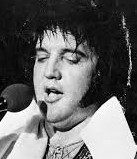
James Brown accidentally leaned on the coffin of Elvis Presley
Previously in the book: Nebraskan Hal Neely began his career touring with big bands and worked his way into Syd Nathan’s King records, producing rock and country songs. Along the way he worked with James Brown, the Godfather of Soul, who referred to Neely as his favorite uncle. Eventually he became one of the owners of Starday-King, until the other owners bought him out.
While Hal Neely’s career began to wind down in the late 1970s and into the 1980s, James Brown was going through a difficult stage of life, too.
Brown’s music seemed to be following trends instead of making them. He didn’t quite know what to make of the disco craze and found himself in the position of being the older man in a young man’s business. Brown would have loved to work with Elvis Presley but that was not to be. Presley admired the work of Jackie Wilson, even though some of the people in his entourage preferred James Brown. Bob Patton, a member of Presley’s staff, recalled that “Elvis came to see him (after a show) and shook hands with him (Brown) but they weren’t close.”
When Presley died in 1977, Patton said, “James wanted to get into Elvis’s funeral. It was arranged to get a limousine to pick James up and take him direct to the house (Graceland) for the ‘viewing’ and everything. And James did that. In fact, when James was there, he was talking to Priscilla and a couple of people and he was standing next to the casket, leaning on it. Fred Davis (a former DJ from Texas who joined Brown’s organization) started to turn white. He says, ‘Mr. Brown, Mr. Brown.’ James looked over and says, ‘Can’t you see I’m talking to people?’ So Fred whispers to him, ‘Mr. Brown, you’re leaning on Mr. Presley.’ If James Brown ever turned close to white, that was it. It took him about a minute and then he recovered.”1
Brown, through his contract with Polydor, found a new fan base in Europe, and toured there regularly from 1977 through 1981. His last album for Polydor was recorded in Tokyo in December of 1979.2
“In destroying my sound, Polydor had cost me my audience, and it was around this time, 1979, that the record business in general collapsed,” Brown said in his autobiography. “They tried to take me over into disco. I was against it from the first. Disco had no groove, it had no sophistication, it had nothing. It was almost over anyway. I fought against doing it but finally gave in. They call the album, ‘The Original Disco Man.’ I was very unhappy with the result.”
After Brown finally terminated his contract with Polydor, he struggled to re-enter the American market. At first the only offers he received were shows being billed as “oldies.” Brown insisted that he was still a contemporary artist and preferred to have his songs called “soul classics.” Eventually he was booked into the rock club circuit in New York.
The development that reinvigorated Brown’s career was a series of cameo appearances in highly successful movies such as “The Blues Brothers.” “Dr. Detroit,” and “Rocky IV” and on television shows such as Saturday Night Live and Solid Gold. However, his nightclub appearances showed his embarrassing move into middle age. “Singer James Brown has found he can no longer perform those wild athletic leaps as he did of yore,” according to a review in the Los Angeles Sentinel in 1981. He attempted a split that “left him prone and reputedly too injured to open a new slated concert at Ripley Music Hall in Philadelphia.” His audience now was mostly white, according to Robert Hillburn of the Los Angeles Times, “both young fans wanting to sample their pop history and the older ones wishing to relive some memories.”3
The bottom literally fell out of James Brown’s career in 1988 after several arrests on drug-related charges. Even though he had appeared with President Ronald Reagan to promote the “Just Say No” anti-drugs campaign and released such songs as “King Heroin” and “Public Enemy No. 1,” he became addicted to powerful drugs including PCP.
In the spring of 1988 he was arrested several times for drugs, weapons and domestic violence offenses. In September he was again arrested after flashing a pistol and shotgun at an insurance seminar resulting in a long police chase which crisscrossed the Georgia and South Carolina state line. A South Carolina sheriff said Brown had been arrested seven times in an eighteen-month period.4
All these arrests culminated with the courts finding him guilty of evading arrest in South Carolina and of attempting to run down two state safety officers. Brown received six years in Georgia and 6 1/2 years in South Carolina which were to be served concurrently.
“I’ve been in slavery all my life, ain’t nothing new,” Brown said in an interview. “It just means I don’t have to answer a whole lot of phone calls. Ain’t nothing changed for me but the address.”5
1 The Starday Story, 165.
2 Record Makers and Breakers, 148.
3 Wilson Interview.
4 Ibid.
5 Williams Interview